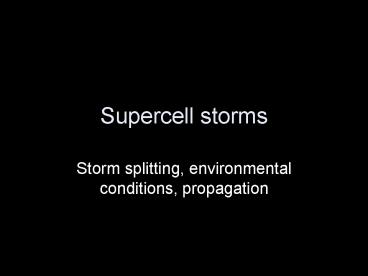Supercell storms - PowerPoint PPT Presentation
1 / 41
Title:
Supercell storms
Description:
(as seen from Laughlin AFB radar in SW Texas) Tornado report. Maverick, TX. Dynamics of storm splitting. Klemp (1987); See Houze p. 288-295 ... – PowerPoint PPT presentation
Number of Views:246
Avg rating:3.0/5.0
Title: Supercell storms
1
Supercell storms
- Storm splitting, environmental conditions,
propagation
2
Ordinary/multicell storm
Browning et al. (1976)
3
Fovell and Tan (1998)
4
Supercell (rotating) storm
Plan view at surface UD updraft FFD forward
flank downdraft RFD rear flank downdraft Gust
front Hook echo Dot tornado location
Lemon and Doswell (1979)
5
Beneath a rotating supercell
Made using ARPS and Vis5D
6
Animation
7
Storm splitting
Wilhelmson and Klemp (1981)
8
Storm splitting
Two symmetric storms result from initial
impulse Yields right left movers Note
rotation Domain is moving to east Made w/
ARPS and Vis5D
9
24 April 2007 splitting storm(as seen from
Laughlin AFB radar in SW Texas)
10
(No Transcript)
11
Tornado report Maverick, TX
12
Dynamics of storm splitting
Klemp (1987) See Houze p. 288-295
13
Shear-induced vortex tubes
14
leads to splitting and rotation
Lifting of vortex tubes by updrafts create
counter-rotating horizontal vortices vertical
vorticity
Low pressure in the vortices establish new
updrafts on original storms flanks
The original storm decays and voila, the storm
appears to have split, yielding counter-rotating
storms
Note now L pressure and updraft are colocated
shear has contributed to storm stabilization
15
Precipitation is NOT involved
Simulations without rain still show storm
splitting
16
Close look at two papers
- Weisman and Klemp (1982)
- Environmental conditions favoring
ordinary/multicell storms and supercell storms - Rotunno and Klemp (1982)
- Why right-movers are favored in U.S.
- Why right-movers move to right of mean winds
17
Weisman and Klemp (1982 WK)
- Dependence of Numerically Simulated Convective
Storms on Vertical Wind Shear and Buoyancy - 3D simulations, started with thermal
- Varied CAPE by manipulating boundary layer
moisture - Considered speed shear only
see Houze, p. 284-288
18
CAPE
- Convective Available Potential Energy
- positive area of a sounding
- Integrated from LFC to EQL
- WK and Houze (eq. 8.1, p. 283) expressions
involve potential temperature - Should involve virtual potential temperature
19
WKs sounding
CAPE varied by setting PBL moisture Standard
case has 14 g/kg
20
WK wind profiles
Us wind speed change over 10 km
Note no directional shear
21
WK Wmax vs. time
q 14 g/kg simulations No shear
case intensifies fastest dies first Larger
shear - slower development By this metric,
moderate shear storm is strongest
22
WK simulations have symmetry axis
No initial flow in N-S direction Initial bubble
is radially symmetric. Therefore, storms have N-S
symmetry
23
WK results
multicellular
supercellular
24
Us 30 m/s, q 14 g/kg
Surface rainwater (g/kg) and surface positive
vorticity (1/s, dashed) Low-level radar
reflectivity field
25
WK response to initial bubble
26
Secondary storms are Subsequent ordinary
cell developments (i.e., multicells) Split
storms are supercells, resulting from splitting
of initial cell
27
WK analysis
Bulk Richardson number ?u avg. wind of lowest
6 km minus avg. wind of lowest 500 m Storm
strength Wmax largest updraft Denominator
theoretical updraft max ignores pressure
perturbation!
28
WK analysis
Larger BRi initial storm stronger more CAPE,
or less shear Largest is 60 of theoretical
max Multicells favored for BRi gt 30 or
so Supercells smaller BRi relatively
larger S
R BRi
29
BRi as predictor of storm mode
30
Concerns w/ BRi
- CAPE
- As formulated in WK (and Houzes eq. 8.1),
moisture in environment neglected (apart from
parcel definition) - Water loading, entrainment neglected
- Convective inhibition (CIN) completely ignored
- Shear
- Relevant depth 6 km? Always?
- Directional shear completely ignored
- Uniqueness of BRi
- Same value for low CAPE/low shear as high
CAPE/high shear. Reasonable to expect same
convective mode and/or intensity? - This has been a very valuable result
31
Rotunno and Klemp (1982 RK)
- Most tornadoes associated with supercells
- tornadoes have same sense of rotation as parent
storm - Further, vast majority of tornadoes are CCW
rotating - after splitting, CW left movers tend to die
(and/or be non-tornadic) - So why are left movers disfavored?
- its directional vertical shear
32
RK hodograph
33
Straight vs. curved hodograph
Note mirror-image storms both have hook-like
echoes Note only right-mover has hook
shape left-mover weaker
34
Straight vs. curved hodograph
W at 1.5 km
Without directional shear, symmetric pulse always
remains symmetric
With directional shear, right mover soon favored
35
Pressure decomposition
- Recall nondimensional pressure perturbation p
subdivided into dynamic and buoyancy pressures - Dynamic pressure can be further partitioned into
linear (L) and nonlinear (NL) pressures using
perturbation analysis
NOTE the overbars the base state winds
36
p caused by vertical shear
p - heavy contours ?? - thin contours Vertical
shear vector shown
X-direction
37
Propagation to left right
On flanks, both CW CCW cause L pressure where
vort is max, min
L
L
Net result L pressure on flanks L pressure
ahead lead to propagation to left and right of
mean winds
38
Unidirectional shear case
Vertical accel largest on E (forward) side
storm moves E Nonlinear p encourages ascent
on flanks -- storm splitting Result
symmetric (neither split storm member is
favored)
Shear vector shown
39
Directional shear case
RKs analysis shows that pNL and buoy favor the
left mover. But pL favors the right mover and
dominates
40
Hodograph with directional shear. Thin shear
vector used for lower-level shear. Circle
indicates updraft. Linear term encourages low
pressure downshear high pressure upshear For
lower-level shear, lowered pressure to NE
41
Upper level shear produces pressure
perturbations in different places On south
side of updraft there is lowered pressure aloft
overlying raised pressure below. This flank
is favored for ascent.































